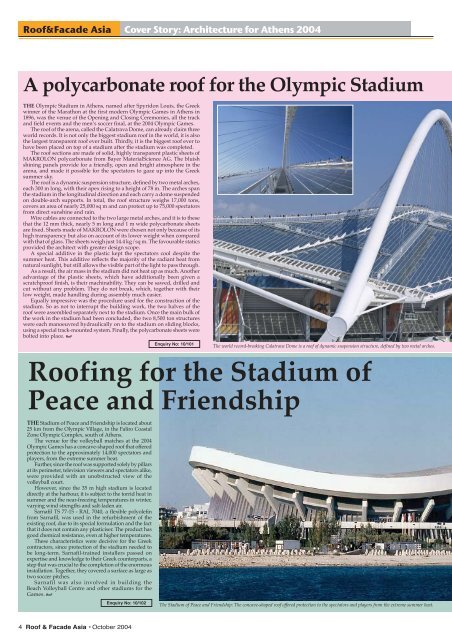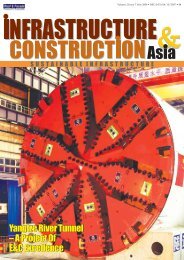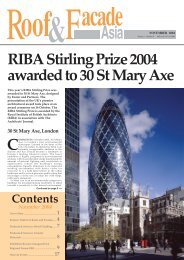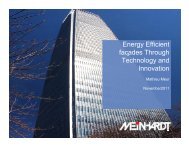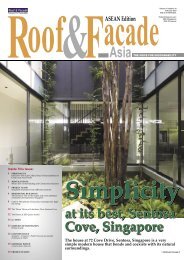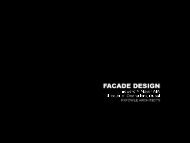Architecture for Athens 2004 - Roof & Facade
Architecture for Athens 2004 - Roof & Facade
Architecture for Athens 2004 - Roof & Facade
Create successful ePaper yourself
Turn your PDF publications into a flip-book with our unique Google optimized e-Paper software.
<strong>Roof</strong>&<strong>Facade</strong> Asia Cover Story: <strong>Architecture</strong> <strong>for</strong> <strong>Athens</strong> <strong>2004</strong><br />
A polycarbonate roof <strong>for</strong> the Olympic Stadium<br />
THE Olympic Stadium in <strong>Athens</strong>, named after Spyridon Louis, the Greek<br />
winner of the Marathon at the first modern Olympic Games in <strong>Athens</strong> in<br />
1896, was the venue of the Opening and Closing Ceremonies, all the track<br />
and field events and the men’s soccer final, at the <strong>2004</strong> Olympic Games.<br />
The roof of the arena, called the Calatrava Dome, can already claim three<br />
world records. It is not only the biggest stadium roof in the world, it is also<br />
the largest transparent roof ever built. Thirdly, it is the biggest roof ever to<br />
have been placed on top of a stadium after the stadium was completed.<br />
The roof sections are made of solid, highly transparent plastic sheets of<br />
MAKROLON polycarbonate from Bayer MaterialScience AG. The bluish<br />
shining panels provide <strong>for</strong> a friendly, open and bright atmosphere in the<br />
arena, and made it possible <strong>for</strong> the spectators to gaze up into the Greek<br />
summer sky.<br />
The roof is a dynamic suspension structure, defined by two metal arches,<br />
each 300 m long, with their apex rising to a height of 78 m. The arches span<br />
the stadium in the longitudinal direction and each carry a dome suspended<br />
on double-arch supports. In total, the roof structure weighs 17,000 tons,<br />
covers an area of nearly 25,000 sq m and can protect up to 75,000 spectators<br />
from direct sunshine and rain.<br />
Wire cables are connected to the two large metal arches, and it is to these<br />
that the 12 mm thick, nearly 5 m long and 1 m wide polycarbonate sheets<br />
are fixed. Sheets made of MAKROLON were chosen not only because of its<br />
high transparency but also on account of its lower weight when compared<br />
with that of glass. The sheets weigh just 14.4 kg/sq m. The favourable statics<br />
provided the architect with greater design scope.<br />
A special additive in the plastic kept the spectators cool despite the<br />
summer heat. This additive reflects the majority of the radiant heat from<br />
natural sunlight, but still allows the visible part of the light to pass through.<br />
As a result, the air mass in the stadium did not heat up as much. Another<br />
advantage of the plastic sheets, which have additionally been given a<br />
scratchproof finish, is their machinability. They can be sawed, drilled and<br />
cut without any problem. They do not break, which, together with their<br />
low weight, made handling during assembly much easier.<br />
Equally impressive was the procedure used <strong>for</strong> the construction of the<br />
stadium. So as not to interrupt the building work, the two halves of the<br />
roof were assembled separately next to the stadium. Once the main bulk of<br />
the work in the stadium had been concluded, the two 8,500 ton structures<br />
were each manoeuvred hydraulically on to the stadium on sliding blocks,<br />
using a special track-mounted system. Finally, the polycarbonate sheets were<br />
bolted into place. RnF<br />
Enquiry No: 10/101<br />
The world record-breaking Calatrava Dome is a roof of dynamic suspension structure, defined by two metal arches.<br />
<strong>Roof</strong>ing <strong>for</strong> the Stadium of<br />
Peace and Friendship<br />
THE Stadium of Peace and Friendship is located about<br />
25 km from the Olympic Village, in the Faliro Coastal<br />
Zone Olympic Complex, south of <strong>Athens</strong>.<br />
The venue <strong>for</strong> the volleyball matches at the <strong>2004</strong><br />
Olympic Games has a concave-shaped roof that offered<br />
protection to the approximately 14,000 spectators and<br />
players, from the extreme summer heat.<br />
Further, since the roof was supported solely by pillars<br />
at its perimeter, television viewers and spectators alike,<br />
were provided with an unobstructed view of the<br />
volleyball court.<br />
However, since the 35 m high stadium is located<br />
directly at the harbour, it is subject to the torrid heat in<br />
summer and the near-freezing temperatures in winter,<br />
varying wind strengths and salt-laden air.<br />
Sarnafil TS 77-15 - RAL 7040, a flexible polyolefin<br />
from Sarnafil, was used in the refurbishment of the<br />
existing roof, due to its special <strong>for</strong>mulation and the fact<br />
that it does not contain any plasticiser. The product has<br />
good chemical resistance, even at higher temperatures.<br />
These characteristics were decisive <strong>for</strong> the Greek<br />
contractors, since protection of the stadium needed to<br />
be long-term. Sarnafil-trained installers passed on<br />
expertise and knowledge to their Greek counterparts, a<br />
step that was crucial to the completion of the enormous<br />
installation. Together, they covered a surface as large as<br />
two soccer pitches.<br />
Sarnafil was also involved in building the<br />
Beach Volleyball Centre and other stadiums <strong>for</strong> the<br />
Games. RnF<br />
Enquiry No: 10/102<br />
The Stadium of Peace and Friendship: The concave-shaped roof offered protection to the spectators and players from the extreme summer heat.<br />
4 <strong>Roof</strong> & <strong>Facade</strong> Asia • October <strong>2004</strong>


